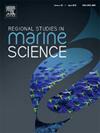eDNA uncovers hidden fish diversity in the coral reef ecosystems of Karimunjawa National Park, Indonesia
IF 2.1
4区 环境科学与生态学
Q3 ECOLOGY
引用次数: 0
Abstract
Environmental DNA (eDNA) has emerged as a powerful tool for swiftly assessing coral reef ecosystems, particularly for detecting fish diversity. This study focused on employing eDNA to investigate fish biodiversity and its functional traits in the Karimunjawa National Park (KNP), Indonesia. The use of eDNA and then validating with visual census results to reveal fish diversity was implemented across four management zones within the park (i.e., the core zone at Taka Malang, the protection zone at Menjangan Kecil Island, the tourism zone at Cilik Island, and an open access location at Genting Island). Sampling involved collecting one liter of seawater per site, filtering, and processing to target the 12S locus, and then sequencing using the MinION machine (Oxford nanopore). The eDNA results show higher species diversity in the tourism zone compared to the core, protection, and open access zones. However, beta diversity analysis revealed no significant differences in community composition between the zones. Moreover, this research revealed 147 species belonging to 31 families, with 60 % species and 30 % families identified solely through eDNA, that were not covered by the visual census. This research also reveals that eDNA is an excellent approach to detecting functional trait diversity, including environment preference and migratory and nocturnal behavior. This research underscores the potential of eDNA for evaluating fish diversity in KNP, proposing a combined eDNA and visual census approach to fill existing gaps in biodiversity assessment. Such integration promises to bolster conservation efforts within Marine Protection Areas like KNP.
求助全文
约1分钟内获得全文
求助全文
来源期刊

Regional Studies in Marine Science
Agricultural and Biological Sciences-Ecology, Evolution, Behavior and Systematics
CiteScore
3.90
自引率
4.80%
发文量
336
审稿时长
69 days
期刊介绍:
REGIONAL STUDIES IN MARINE SCIENCE will publish scientifically sound papers on regional aspects of maritime and marine resources in estuaries, coastal zones, continental shelf, the seas and oceans.
 求助内容:
求助内容: 应助结果提醒方式:
应助结果提醒方式:


